Abstract
BACKGROUND: Oncogenicity of human papillomavirus (HPV) DNA in premalignant and malignant uterine cervical diseases is mainly induced by E6/E7 open reading frame (ORF). The presence of an oncogenic HPV DNA may be a diagnostic marker for the detection of cytologically negative smears. AIMS: To evaluate an original polymerase chain reaction enzyme immunoassay (PCR-EIA) for the detection and typing of oncogenic and non-oncogenic HPV types. METHODS: The test was an original multiplex labelled PCR-EIA for the detection and typing of oncogenic and non-oncogenic HPV using three consensus sequence primers within the oncogenic E6/E7 ORF. One primer was dinitrophenyl (DNP) labelled and the DNP labelled amplimers could be further hybridised with specific biotinylated oligoprobes mixed in only two cocktails: oncogenic (16, 18, 31, 33, 35, 52, and 58) and non-oncogenic (6 and 11) HPV types in only two wells; then biotinylated oligoprobes were deposited in streptavidin-coated microplates. The PCR-EIA was validated on HPV plasmids (types 6, 11, 16, 18, 31, 35, 52, and 58) and used to evaluate cervical scrapes from 181 patients (median age 32 years) at high risk for cervical cancer. RESULTS: HPV were detected in the cervical scrapes of 88 of 181 patients (48.6%); nine with non-oncogenic HPV (5.0%) and 79 with oncogenic HPV (43.6%) including 29 coinfections with oncogenic and non-oncogenic HPV. The number of oncogenic HPV infections increased with the presence of high grade lesions: 95.8% of the cervical scrapes from patients with high grade lesions contained oncogenic HPV compared with 32.1% of the specimens from patients without any lesions detectable by colposcopy and/or by cytological examination of the cervical smears. Moreover, 60% of cervical scrapes exhibiting low grade lesions contained oncogenic HPV. CONCLUSIONS: This test is simple, specific, sensitive, safe, fast, reproducible, and easy to use in routine practice. Thus, it is possible to detect simultaneously on a simple cervical scrape, two kinds of HPV--oncogenic and non-oncogenic--in just two microplate wells with non-isotopic oligoprobes.
Full text
PDF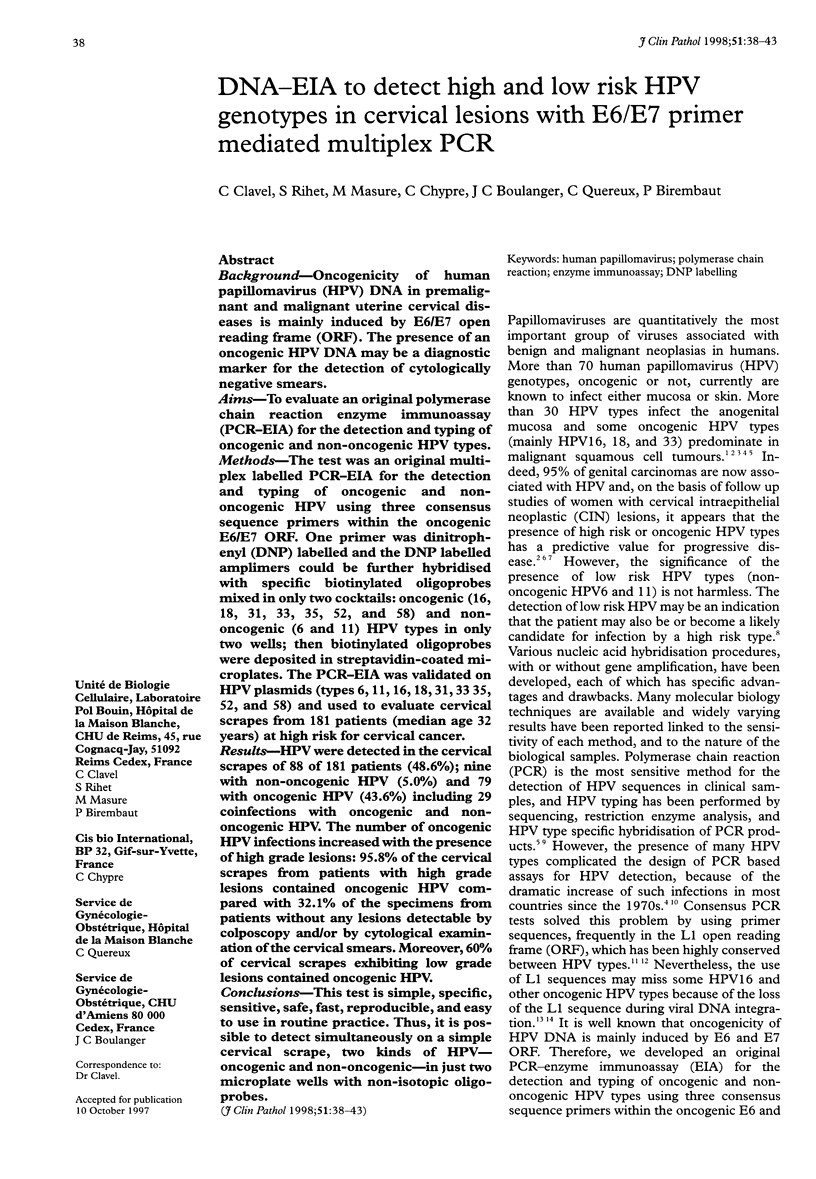
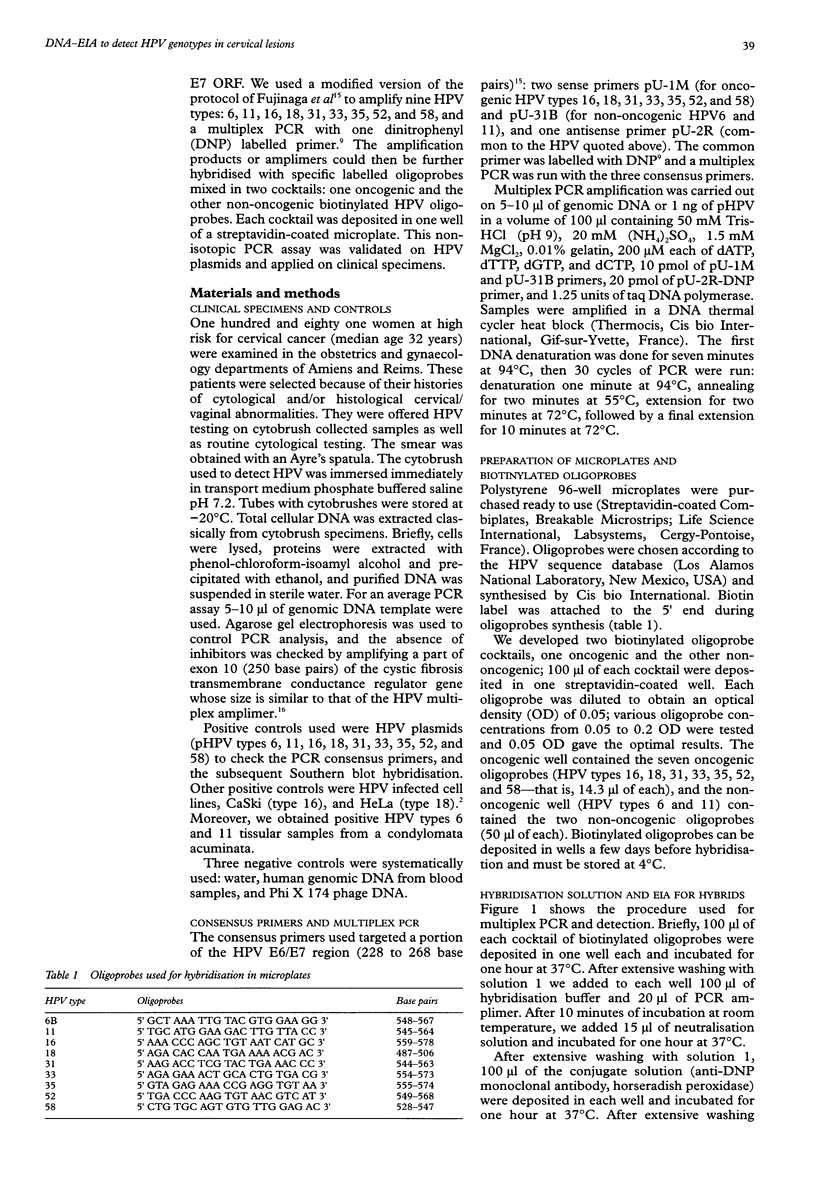
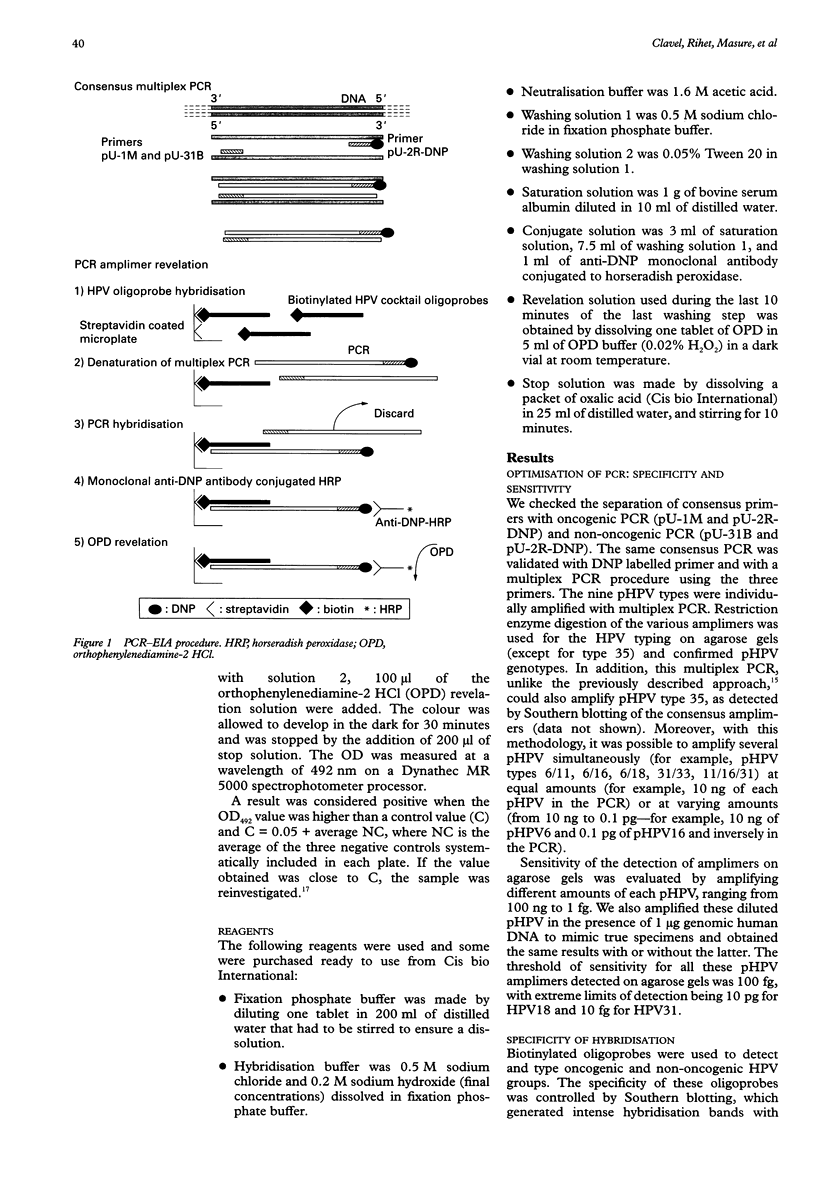
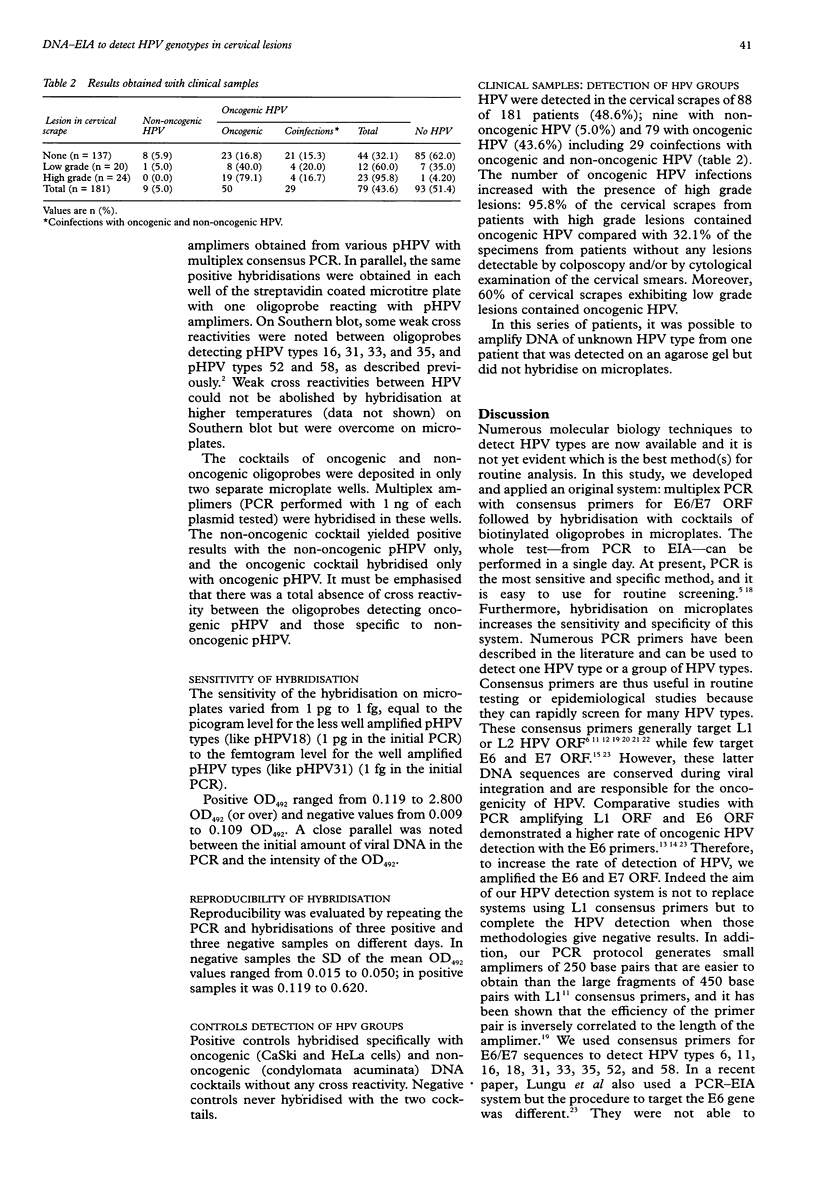
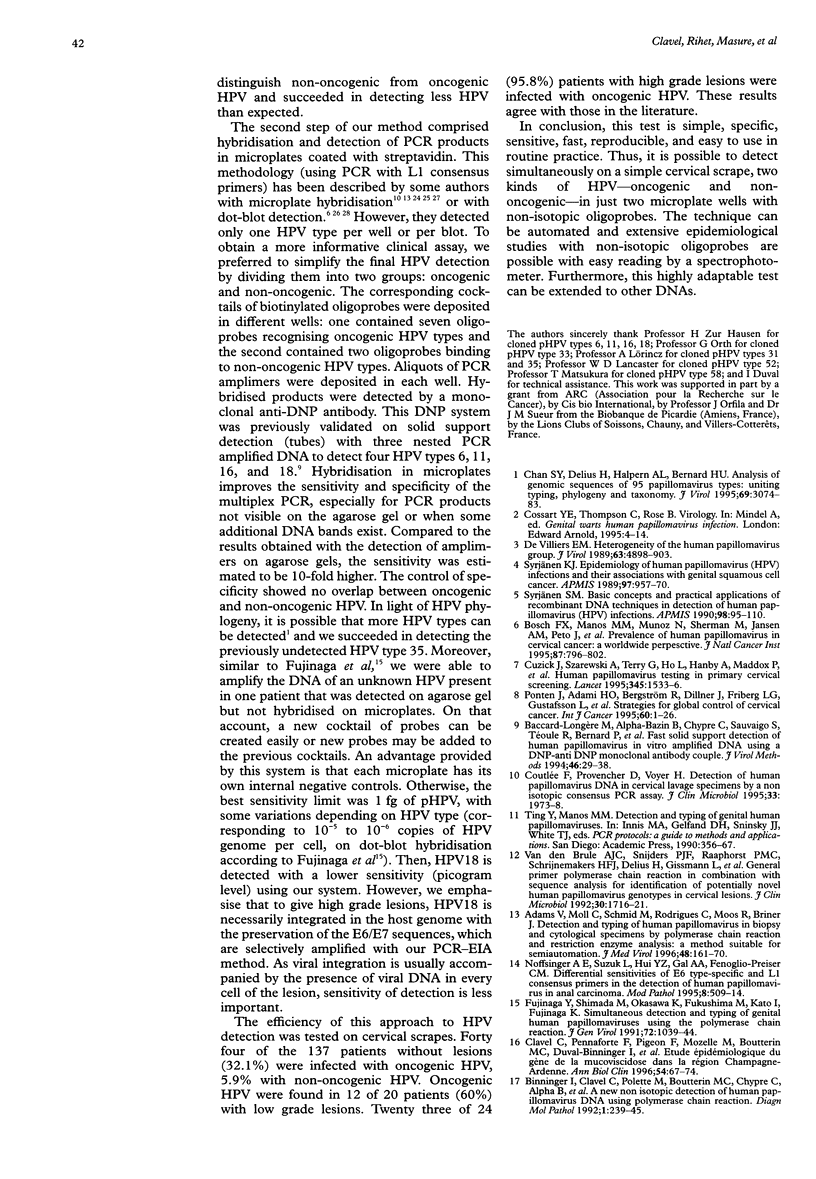

Selected References
These references are in PubMed. This may not be the complete list of references from this article.
- Adams V., Moll C., Schmid M., Rodrigues C., Moos R., Briner J. Detection and typing of human papillomavirus in biopsy and cytological specimens by polymerase chain reaction and restriction enzyme analysis: a method suitable for semiautomation. J Med Virol. 1996 Feb;48(2):161–170. doi: 10.1002/(SICI)1096-9071(199602)48:2<161::AID-JMV8>3.0.CO;2-7. [DOI] [PubMed] [Google Scholar]
- Baay M. F., Quint W. G., Koudstaal J., Hollema H., Duk J. M., Burger M. P., Stolz E., Herbrink P. Comprehensive study of several general and type-specific primer pairs for detection of human papillomavirus DNA by PCR in paraffin-embedded cervical carcinomas. J Clin Microbiol. 1996 Mar;34(3):745–747. doi: 10.1128/jcm.34.3.745-747.1996. [DOI] [PMC free article] [PubMed] [Google Scholar]
- Baccard-Longère M., Alpha-Bazin B., Chypre C., Sauvaigo S., Téoule R., Bernard P., Seigneurin J. M. Fast solid support detection of human papillomavirus in in vitro amplified DNA using a DNP-anti DNP monoclonal antibody couple. J Virol Methods. 1994 Jan;46(1):29–38. doi: 10.1016/0166-0934(94)90014-0. [DOI] [PubMed] [Google Scholar]
- Binninger I., Clavel C., Polette M., Boutterin M. C., Chypre C., Alpha B., Birembaut P. A new nonisotopic detection of human papillomavirus DNA using polymerase chain reaction. Diagn Mol Pathol. 1992 Dec;1(4):239–245. [PubMed] [Google Scholar]
- Bosch F. X., Manos M. M., Muñoz N., Sherman M., Jansen A. M., Peto J., Schiffman M. H., Moreno V., Kurman R., Shah K. V. Prevalence of human papillomavirus in cervical cancer: a worldwide perspective. International biological study on cervical cancer (IBSCC) Study Group. J Natl Cancer Inst. 1995 Jun 7;87(11):796–802. doi: 10.1093/jnci/87.11.796. [DOI] [PubMed] [Google Scholar]
- Chan S. Y., Delius H., Halpern A. L., Bernard H. U. Analysis of genomic sequences of 95 papillomavirus types: uniting typing, phylogeny, and taxonomy. J Virol. 1995 May;69(5):3074–3083. doi: 10.1128/jvi.69.5.3074-3083.1995. [DOI] [PMC free article] [PubMed] [Google Scholar]
- Chua K. L., Hjerpe A. Polymerase chain reaction analysis of human papillomavirus in archival cervical cytologic smears. Anal Quant Cytol Histol. 1995 Aug;17(4):221–229. [PubMed] [Google Scholar]
- Clavel C., Pennaforte F., Pigeon F., Mozelle M., Boutterin M. C., Duval-Binninger I., F-erec C., Birembaut P. Etude épidémiologique du gène de la mucoviscidose dans la région Champagne-Ardenne. Ann Biol Clin (Paris) 1996;54(2):67–74. [PubMed] [Google Scholar]
- Coutlée F., Provencher D., Voyer H. Detection of human papillomavirus DNA in cervical lavage specimens by a nonisotopic consensus PCR assay. J Clin Microbiol. 1995 Aug;33(8):1973–1978. doi: 10.1128/jcm.33.8.1973-1978.1995. [DOI] [PMC free article] [PubMed] [Google Scholar]
- Coutlée F., Provencher D., Voyer H. Detection of human papillomavirus DNA in cervical lavage specimens by a nonisotopic consensus PCR assay. J Clin Microbiol. 1995 Aug;33(8):1973–1978. doi: 10.1128/jcm.33.8.1973-1978.1995. [DOI] [PMC free article] [PubMed] [Google Scholar]
- Cuzick J., Szarewski A., Terry G., Ho L., Hanby A., Maddox P., Anderson M., Kocjan G., Steele S. T., Guillebaud J. Human papillomavirus testing in primary cervical screening. Lancet. 1995 Jun 17;345(8964):1533–1536. doi: 10.1016/s0140-6736(95)91086-7. [DOI] [PubMed] [Google Scholar]
- Fujinaga Y., Shimada M., Okazawa K., Fukushima M., Kato I., Fujinaga K. Simultaneous detection and typing of genital human papillomavirus DNA using the polymerase chain reaction. J Gen Virol. 1991 May;72(Pt 5):1039–1044. doi: 10.1099/0022-1317-72-5-1039. [DOI] [PubMed] [Google Scholar]
- Gjøoen K., Olsen A. O., Magnus P., Grinde B., Sauer T., Orstavik I. Prevalence of human papillomavirus in cervical scrapes, as analyzed by PCR, in a population-based sample of women with and without cervical dysplasia. APMIS. 1996 Jan;104(1):68–74. doi: 10.1111/j.1699-0463.1996.tb00688.x. [DOI] [PubMed] [Google Scholar]
- Gregoire L., Arella M., Campione-Piccardo J., Lancaster W. D. Amplification of human papillomavirus DNA sequences by using conserved primers. J Clin Microbiol. 1989 Dec;27(12):2660–2665. doi: 10.1128/jcm.27.12.2660-2665.1989. [DOI] [PMC free article] [PubMed] [Google Scholar]
- Herrington C. S., Evans M. F., Hallam N. F., Charnock F. M., Gray W., McGee J. D. Human papillomavirus status in the prediction of high-grade cervical intraepithelial neoplasia in patients with persistent low-grade cervical cytological abnormalities. Br J Cancer. 1995 Jan;71(1):206–209. doi: 10.1038/bjc.1995.42. [DOI] [PMC free article] [PubMed] [Google Scholar]
- Jacobs M. V., Snijders P. J., van den Brule A. J., Helmerhorst T. J., Meijer C. J., Walboomers J. M. A general primer GP5+/GP6(+)-mediated PCR-enzyme immunoassay method for rapid detection of 14 high-risk and 6 low-risk human papillomavirus genotypes in cervical scrapings. J Clin Microbiol. 1997 Mar;35(3):791–795. doi: 10.1128/jcm.35.3.791-795.1997. [DOI] [PMC free article] [PubMed] [Google Scholar]
- Jacobs M. V., de Roda Husman A. M., van den Brule A. J., Snijders P. J., Meijer C. J., Walboomers J. M. Group-specific differentiation between high- and low-risk human papillomavirus genotypes by general primer-mediated PCR and two cocktails of oligonucleotide probes. J Clin Microbiol. 1995 Apr;33(4):901–905. doi: 10.1128/jcm.33.4.901-905.1995. [DOI] [PMC free article] [PubMed] [Google Scholar]
- Lungu O., Sun X. W., Wright T. C., Jr, Ferenczy A., Richart R. M., Silverstein S. A polymerase chain reaction-enzyme-linked immunosorbent assay method for detecting human papillomavirus in cervical carcinomas and high-grade cervical cancer precursors. Obstet Gynecol. 1995 Mar;85(3):337–342. doi: 10.1016/0029-7844(94)00399-x. [DOI] [PubMed] [Google Scholar]
- Noffsinger A. E., Suzuk L., Hui Y. Z., Gal A. A., Fenoglio-Preiser C. M. Differential sensitivities of E6 type-specific and L1 consensus primers in the detection of human papillomavirus in anal carcinoma. Mod Pathol. 1995 Jun;8(5):509–514. [PubMed] [Google Scholar]
- Poljak M., Seme K. Rapid detection and typing of human papillomaviruses by consensus polymerase chain reaction and enzyme-linked immunosorbent assay. J Virol Methods. 1996 Feb;56(2):231–238. doi: 10.1016/0166-0934(95)01969-3. [DOI] [PubMed] [Google Scholar]
- Pontén J., Adami H. O., Bergström R., Dillner J., Friberg L. G., Gustafsson L., Miller A. B., Parkin D. M., Sparén P., Trichopoulos D. Strategies for global control of cervical cancer. Int J Cancer. 1995 Jan 3;60(1):1–26. doi: 10.1002/ijc.2910600102. [DOI] [PubMed] [Google Scholar]
- Sangiuolo F., De Santis L., Cavicchini A., Angeloni U., Romanini C., Novelli G., Dallapiccola B. A new method for direct analysis of polymerase chain reaction-amplified human papillomavirus using DNA enzyme immunoassay. Int J Clin Lab Res. 1994;24(4):223–226. doi: 10.1007/BF02592468. [DOI] [PubMed] [Google Scholar]
- Syrjänen K. J. Epidemiology of human papillomavirus (HPV) infections and their associations with genital squamous cell cancer. Review article. APMIS. 1989 Nov;97(11):957–970. doi: 10.1111/j.1699-0463.1989.tb00504.x. [DOI] [PubMed] [Google Scholar]
- Syrjänen S. M. Basic concepts and practical applications of recombinant DNA techniques in detection of human papillomavirus (HPV) infection. Review article. APMIS. 1990 Feb;98(2):95–110. doi: 10.1111/j.1699-0463.1990.tb01008.x. [DOI] [PubMed] [Google Scholar]
- de Villiers E. M. Heterogeneity of the human papillomavirus group. J Virol. 1989 Nov;63(11):4898–4903. doi: 10.1128/jvi.63.11.4898-4903.1989. [DOI] [PMC free article] [PubMed] [Google Scholar]
- van den Brule A. J., Snijders P. J., Raaphorst P. M., Schrijnemakers H. F., Delius H., Gissmann L., Meijer C. J., Walboomers J. M. General primer polymerase chain reaction in combination with sequence analysis for identification of potentially novel human papillomavirus genotypes in cervical lesions. J Clin Microbiol. 1992 Jul;30(7):1716–1721. doi: 10.1128/jcm.30.7.1716-1721.1992. [DOI] [PMC free article] [PubMed] [Google Scholar]


